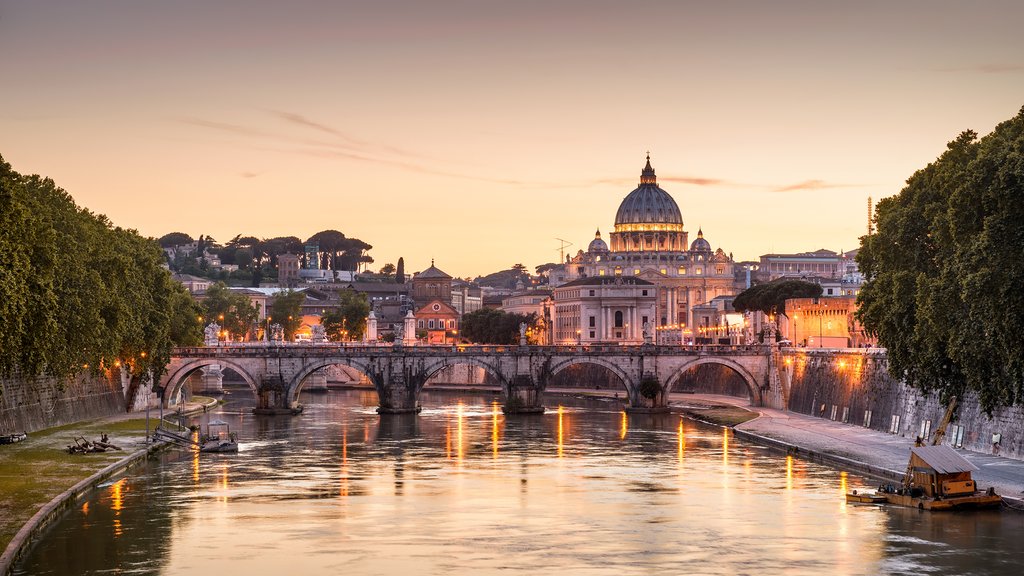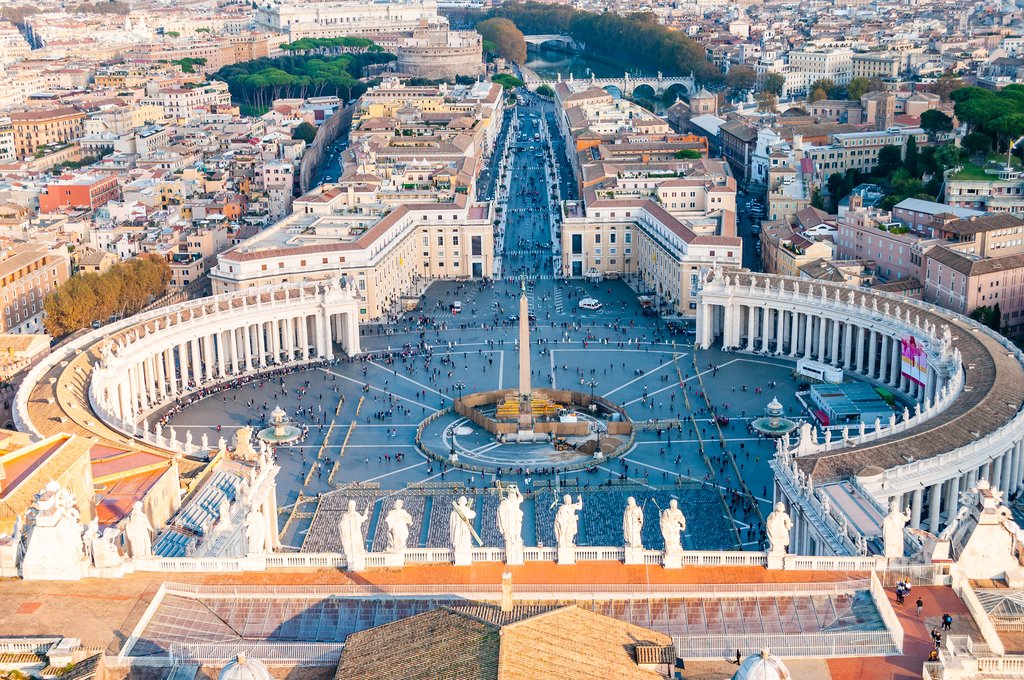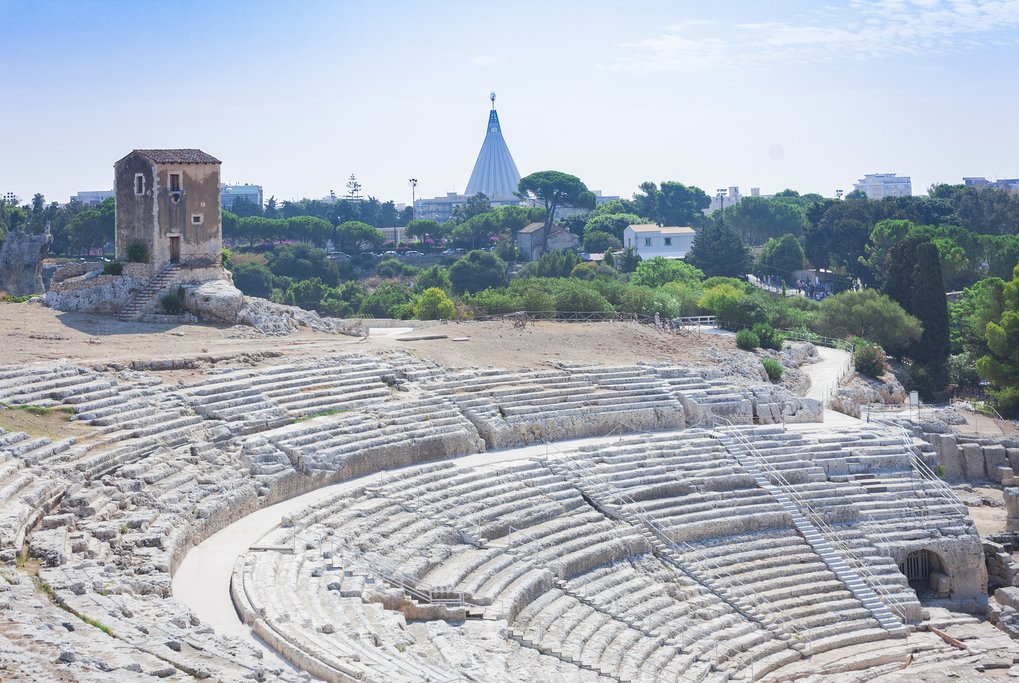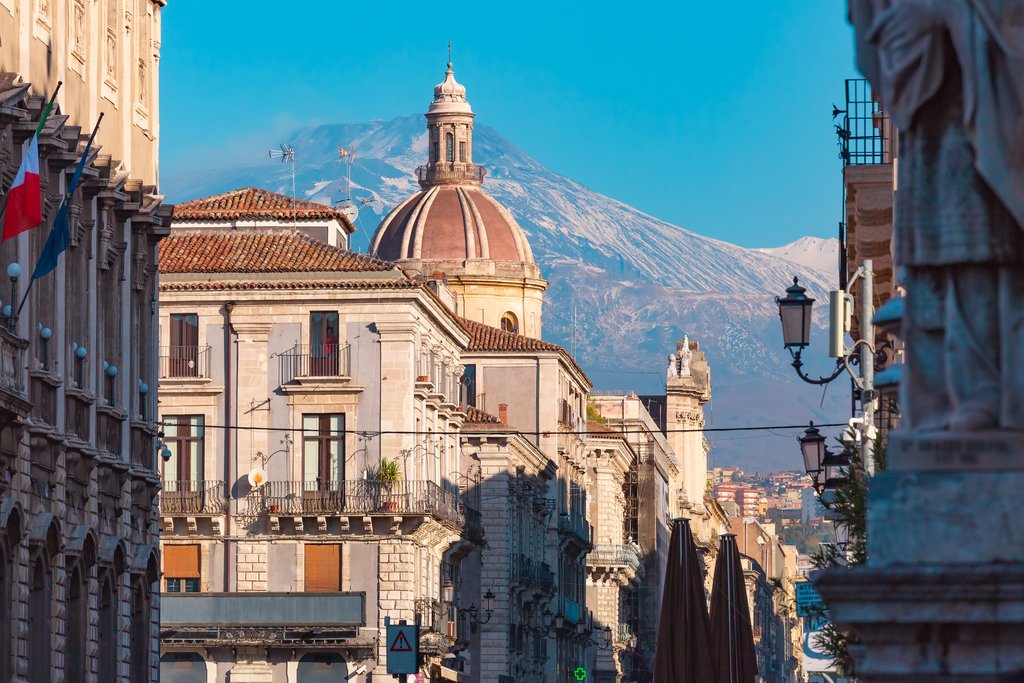
Rome & Sicily Highlights - 16 Days

Highlights
- Go back in time to ancient Rome with a tour of the Colosseum
- Tour the halls and basilicas of the Vatican
- Cool off by the Pretoria Fountain in Palermo
- Visit ancient Greek and Roman ruins at Agrigento and Syracuse
- Dine on fresh seafood in sophisticated Taormina
Brief Itinerary
| Day | Highlights | Overnight |
|---|---|---|
| Day 1 | Arrival in Rome | Rome |
| Day 2 | Vatican & Classic Tour of Rome | Rome |
| Day 3 | Private Colosseum & Forum Tour - Cooking Class | Rome |
| Day 4 | Galleria Borghese - Free Afternoon in Rome | Rome |
| Day 5 | Fly From Rome to Palermo - Pick up Rental Car | Palermo |
| Day 6 | Guided Tour of Palermo - Visit Monreale | Palermo |
| Day 7 | Drive From Palermo to Marsala - Visit Erice | Marsala |
| Day 8 | Explore Marsala & Wine Tasting - Drive to Agrigento | Agrigento |
| Day 9 | Guided Tour of Valley of the Temples | Agrigento |
| Day 10 | Drive From Agrigento to Syracuse - Tour Villa Romana del Casale | Syracuse |
| Day 11 | Guided Tour of Syracuse | Syracuse |
| Day 12 | Day Trip From Syracuse to Ragusa Ibla, Modica, & Scicli | Syracuse |
| Day 13 | Drive From Syracuse to Taormina - Mount Etna Hike | Taormina |
| Day 14 | Explore Taormina | Taormina |
| Day 15 | Drive From Taormina to Catania - Fly to Rome | Rome |
| Day 16 | Goodbye, Italy |
Detailed Itinerary
Day 1: Arrival in Rome

Welcome to Rome, City of the Seven Hills! According to legend, Rome was founded by brothers Romulus and Remus in 753 B.C.E. atop Palatine Hill. The long-time center of the powerful Roman Empire, Rome boasts nearly 3,000 years of architecture, history, and culture.
After arriving at one of Rome's airports, you'll transfer to your hotel in the historic center. Settle in and relax, then head out for a stroll and your first look at the Eternal City. Your next few days will involve lots of sightseeing, so check out some of Rome's landmarks and sites.
For an authentic market experience stop by the Mercato dei Fiori, where locals shop for fresh vegetables, a wide selection of flowers, meats, and cheeses. Browse for authentic Italian pasta and other souvenirs then take a break with coffee and a pastry at one of the many cafes surrounding the market.
Day 2: Vatican & Classic Tour of Rome

Today you will visit the Vatican City museums and Sistine Chapel, as well as other top sights for an exclusive 6-hour tour of the city's incredible art and history. Start at the Vatican, where you'll visit the Pio Clementio Museum, Gallery of the Candelabra, Gallery of Tapestries, and Gallery of the Geographical Maps.
Continue to see the magnificent Raphael Rooms, ending in the breathtaking Sistine Chapel and St. Peter's Basilica. Experience the magic of Renaissance art as you learn about the secret details and untold stories of the masterpieces.
Afterward, continue into a city for a tour of the city's most notable landmarks. Cross Piazza della Repubblica to see the Fountain of the Nyands, then continue to see the Trevi Fountain, La Colonna di Marco Aurelio, and the Palazzo di Montecitorio, which was designed by Bernini.
Admire the exterior of the Pantheon and head inside for a look at the ancient Roman temple, then head to Palazzo Madama—the Senate seat—ending at Piazza Navona.
End your evening with a stroll to the neighborhood piazza for gelato and some people watching.
Day 3: Private Colosseum & Forum Tour - Cooking Class

In the morning meet your archaeologist guide and dive into the history of the Roman Empire with a private guided walking tour of the Colosseum, the world's largest amphitheater (tickets included). You'll explore the main complex, as well as the Belvedere, the recently opened third ring with a view of the arena and the Imperial Forums up to the fourth and fifth rings.
Walking through the ancient amphitheater is like taking a trip back in time to the days of the Roman Empire. At its prime, the Colosseum held 50,000 spectators and was the central venue for gladiator fights. Learn about some of ancient Rome's most famous and illustrious citizens, such as Julius Caesar, Emperors Augustus and Nero, and the Flavian Emperors who built the Colosseum.
From here, continue to the Roman Forum and Palatine Hill, built between 46 BCE and 113 CEC. Walk along the ancient Roman street Via Sacra to see the Temples of Vesta, Antonino, and Faustina. See the ancient Basilica Julia and Aemilia and experience the grandeur of the Roman Empire.
Enjoy some time to yourself, then, in the afternoon, head to a cooking class to learn to make traditional Roman pasta specialties. You'll make Cacio e Pepe, Carbonara, and Amatriciana—all Italian favorites. Start with a combination of great local ingredients (pecorino cheese, fresh meat, and eggs), then make the perfect sauce with fresh market vegetables. Form the homemade dough into the classic pasta shapes and combine everything for a delicious meal.
Once you're finished, sit down to enjoy your creations for dinner paired with the perfect glass of wine.
Day 4: Galleria Borghese - Free Afternoon in Rome

Today is a free day to explore the city. Head to Galleria Borghese, one of the world's premier art museums, for a self-guided visit to see works by extraordinary artists Bernini, Caravaggio, Canova, and Rafaello. The gallery's highlights include sculptures and paintings from Cardinal Scipione Borghese’s collection (1579 - 1633).
Admire Caravaggio's most important paintings, including "Boy with Basket of Fruit", and see Bernini and Canova's sculpture collection, boasting works such as "Apollo and Daphne" and "David". Rafaello's "Entombment of Christ" is also a must-see.
Walk through the ornate rooms and explore the splendid frescoes, stories, and masterful techniques behind the masterpieces. End the tour with a peaceful stroll around the Villa Borghese gardens, enjoying its beauty and calm far from the chaos of the city. Please note that although this is a self-guided tour, a guided option is also available.
In the evening head back to the Trastevere neighborhood for dinner at an osteria or a trattoria, followed by drinks at a trendy wine bar.
Day 5: Fly From Rome to Palermo - Pick up Rental Car

Today, a transfer will take you to the airport where you'll board a one-hour flight to Palermo. Sicily's regional capital boasts beautiful Mediterranean weather and a long and storied history with Roman, Byzantine, Arab, and Norman influences. You'll see this mix of cultures reflected in Palermo's architecture, music, and cuisine.
Upon arrival at the airport, you'll pick up your rental car and drive 45 minutes to your hotel in the heart of the city to settle in. The rest of the day is yours to spend as you like.
You can discover Palermo right away on a self-guided walking tour. The best place to begin is Palermo's historic center. Its medieval streets are easy to navigate by foot, and there are many attractions and restaurants within walking distance. To get your bearings, take a passeggiata (stroll) along the narrow Via Maqueda, a pedestrianized thoroughfare that connects the north of the city to the south. A good place to start is the Fontana Pretoria, a Baroque fountain in the Piazza Pretoria.
Day 6: Guided Tour of Palermo - Visit Monreale

In the morning you will meet your guide for a private half-day tour of the Sicilian capital. Quattro Canti (officially known as Piazza Vigliena), Palazzo Reale, the 12th-century Duomo (the Palermo Cathedral), and Marina Square are some examples of the architectural masterpieces you'll come across. You'll also visit Capo Market, a great spot to pick up some lunch or a typical snack like panelle (chickpea fritters) and cazzilli (pan-fried potato croquettes).
In the afternoon, you might consider driving a short way to the town of Monreale. On the slopes of Monte Caputo, you'll discover what is thought to be the greatest example of Norman architecture in the world, the Cattedrale di Monreale (Monreale Cathedral). This 12th-century UNESCO Heritage Site is made up of ornate cloisters and gold mosaics featuring scenes from the Old and New Testaments. Admire the Norman-Byzantine art and architecture as you tour this national monument.
When you're ready, spend a little time wandering Monreale itself. Consider a stroll through the Belvedere public garden where you can enjoy a beautiful view over the Conca d'Oro below, a fertile valley abounding with citrus trees.
Chat with a local specialist who can help organize your trip.
Day 7: Drive From Palermo to Marsala - Visit Erice

This morning you'll drive two hours west along the coast to the medieval town of Erice. Perched on a cliff that offers magnificent views, Erice is famous for its winding streets, stone archways, and decorated courtyards. Enter by the Porta Trapani, then walk to the historic city center and the 14th-century Duomo. Follow the ancient city walls and visit the Castello di Venere, a 12th-century Norman defensive fortress which houses ruins of a Roman spa and the Temple of Venus.
When you're ready, drive one hour south along the western edge of Sicily toward Marsala, taking in the stunning views of the salt pans that edge the sea. Dotted with historic windmills and saltwater lagoons, these salt flats create a chessboard pattern evoking an otherworldly landscape. Spend a little time walking the pathways that run the length of the dry seawater basins before reaching Marsala and your hotel. After checking in, set out to explore your surroundings.
A city well known for its fortified wine of the same name, its baroque old town center is pedestrian-friendly and offers pretty views of baroque buildings, peppered with elegant piazzas.
Day 8: Explore Marsala & Wine Tasting - Drive to Agrigento

Enjoy a leisurely morning of self-guided exploration with a visit to the Baglio Anselmi Archaeological Museum to learn of Marsala's epic past. Here you'll find impressive artifacts, including a Phoenician boat from the First Punic War among other historic discoveries. And when it's time, you'll find your way to a local cantina to meet the winemakers as well as to sample a varietal or two (or three!) of the fortified Marsala wine paired with regional specialties.
From here, drive two hours to Agrigento, a hilltop city on Sicily's southwestern shore. After checking into your hotel, set out to explore your surroundings. Stroll through Agrigento's densely-packed historical core, finding your way to Via Atenea, the main thoroughfare lined with shops, restaurants, and bars. Leading off Via Atenea, you'll climb your way upwards through a maze of cobblestoned narrow alleys and side streets past 18th and 19th-century palazzi (noble homes or mansions).
Day 9: Guided Tour of Valley of the Temples

You'll have the whole day to explore Agrigento and its popular UNESCO World Heritage archaeological site, the Valley of the Temples, a ridge that's home to well-preserved ancient Greek temples. Here you'll meet with a licensed guide to walk through the ancient city of Akragas with the option to spend time at the popular archaeological museum.
Along the way, you'll stop to marvel at the temples of Hera, Concordia, and Herakles as your expert guide reveals historical insight that brings the ruins to life. You'll also learn how these ridge-top temples once served as beacons for homecoming sailors. After the tour, you'll have the rest of the day to spend as you like.
Day 10: Drive From Agrigento to Syracuse - Tour Villa Romana del Casale

After breakfast, you'll make the drive from Agrigento to discover the elaborate UNESCO-protected Villa Romana del Casale. Here you'll meet with a licensed guide to discover some of the world's best-preserved and varied Roman mosaics as you explore the grounds of this ancient Roman villa. Incredibly luxurious and built on a vast scale, Villa Romana del Casale was probably made for a member of ancient Rome’s elite.
Afterward, you'll drive two hours east to the island of Ortygia, the historical heart of the city of Syracuse, and check into your hotel. Sometimes called Città Vecchia (Old City), Ortygia is an easily walkable area full of treasures waiting to be discovered. Perhaps begin with a walk around the island before ducking into the network of narrow and winding alleyways, passing churches and baroque palaces as you go. You can't go wrong here, as everything is a visual treat.
Day 11: Guided Tour of Syracuse

Take the day to immerse yourself in historic Syracuse, a UNESCO World Heritage Site. Renowned for its rich Greek history, culture, architecture, as well as the birthplace of engineer and mathematician Archimedes, Syracuse was long regarded as one of the major powers in the Mediterranean.
Dedicate the morning to explore the ancient ruins of the Ionian coast on a guided tour of Syracuse (about three hours). Venture to the Neapolis Archaeological Park for a stroll among the ruins and ancient relics together with your expert guide. Learn about the region's Greek and Roman history as you explore the architecture and then continue the walking tour through Ortygia—Syracuse's beautiful old town, located on a spit of land which extends into the Mediterranean.
Afterward, you'll have the afternoon free. Lose yourself in Syracuse's winding streets and discover hidden gems like the late 19th-century Palazzo Impellizzeri, done in the indulgent Rococo style. There's also the Temple of Apollo in Piazza Pancali, and the underground San Giovanni Crypt and Catacombs, which date back to the 6th century. Alternatively, if you're in need of a little relaxation, laze on the golden sands of Arenella Beach, just 20 minutes south of Syracuse.
Day 12: Day Trip From Syracuse to Ragusa Ibla, Modica, & Scicli

Today is a free day to spend as you choose. You might like to make the most of your proximity to the incredible UNESCO-listed cities of Ragusa Ibla, Modica, and Scicli. In 1693 a devastating earthquake almost erased every town and city in southeastern Sicily after which they were rebuilt in the Sicilian Baroque style.
First, drive 1.5 hours west to the hilltop town of Ragusa Ibla. You can meander the narrow lanes of its historic center, stopping to relax in a café or gelateria. If you're up for it, climb the 250 steps to the 18th-century Duomo di San Giorgio, a great example of baroque style. For more exercise, head up the stairs to Ragusa's upper town for breathtaking views. Alternatively, you can take a ride on the trenino (little train) from the Piazza Duomo along the city streets.
About 30 minutes south of Ragusa Ibla is Modica. Built on the sides of a canyon, this city is known for its artisanal chocolate. Wander its labyrinthine streets through Modica Bassa (Lower Modica), where you'll find many restaurants amid elegant 18th/19th-century buildings. Follow the alleyways up to medieval Modica Alta (Upper Modica) and Pizzo Belvedere for stunning views over the Modica Valley. Don't miss Duomo of San Giorgio, Modica's main church and a UNESCO landmark.
If there's time, travel south (20 minutes) to the ancient town of Scicli. You can stroll its pedestrianized Via Penna for nice views of nearby baroque palaces and churches, or visit one of its most beautiful baroque buildings, the Palazzo Beneventano, located on nearby Via Duce d'Aosta. If there's time, take the zig-zagging path up to the 19th-century San Matteo Church. Perched on a cliff, it affords sweeping vistas of the town below. You can also visit an old cave settlement in the Chiafura district.
After a full day, when you're ready, make the 1.5-hour drive back to Syracuse.
Day 13: Drive From Syracuse to Taormina - Mount Etna Hike

The day begins early with a two-hour drive up the coast and inland to Europe's largest active volcano, Mount Etna. You'll arrive at Rifugio Sapienza, Etna's southern access point, and prepare for a guided hike. After organizing your equipment, you'll ride a cable car up 9,500 feet (2,900 meters) to Torre del Filosofo, the last accessible lookout point before the summit. Enjoy the breathtaking scenery that includes solidified lava flows, smoke fumaroles, and wide vistas that stretch out to the Mediterranean.
After Etna, you'll continue driving 1.5 hours to Taormina, a sophisticated resort town located on the Ionian Sea. It's famous for gorgeous coastal views and its ancient Greek theater, the Teatro Antico di Taormina, which is still used for opera and theatre performances. You can also visit the 17th-century Catholic Santa Caterina Church and stroll along the Vicolo Stretto, the narrowest street in town.
Day 14: Explore Taormina

Enjoy a leisurely day exploring on your own. Perhaps take the morning to walk across the spit of land to Isola Bella and discover the 17th-century palace, gardens, and fishing village. Alternatively, there's the medieval castle and narrow, hilly streets of Castelmola, a small village located 3 miles (5 km) north of Taormina. And if you're in want of a beach day, there's the Taormina Mare, an impressive stretch of rocky coastline with many lidos (public beaches), restaurants, and cafés.
Cap off the day with a scoop of gelato as you take a passegiata along the seafront promenade to enjoy the old gardens of the Villa Comunale.
Day 15: Drive From Taormina to Catania - Fly to Rome

After breakfast, make the hour drive south to Catania. Sicily's second-largest city next to Palermo, Catania sits at the foot of Mount Etna and deserves a little exploration if there's time before catching your departure flight. Depending on traffic, it typically takes 15 to 20 minutes to travel from Catania's center to the airport. Best to arrive at least two hours prior to your international departure (and with some extra time to drop off your rental car).
Day 16: Goodbye, Italy

After one last cappuccino over breakfast, head to the airport for your connecting flight home. Have a good trip!
